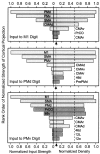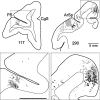Frontal lobe inputs to the digit representations of the motor areas on the lateral surface of the hemisphere
- PMID: 15703391
- PMCID: PMC6726000
- DOI: 10.1523/JNEUROSCI.3902-04.2005
Frontal lobe inputs to the digit representations of the motor areas on the lateral surface of the hemisphere
Abstract
We examined the frontal lobe connections of the digit representations in the primary motor cortex (M1), the dorsal premotor area (PMd), and the ventral premotor area (PMv) of cebus monkeys. All of these digit representations lie on the lateral surface of the hemisphere. We used intracortical stimulation to identify the digit representations physiologically, and then we injected different tracers into two of the three cortical areas. This approach enabled us to compare the inputs to two digit representations in the same animal. We found that the densest inputs from the premotor areas to the digit representation in M1 originate from the PMd and the PMv. Both of these premotor areas contain a distinct digit representation, and the two digit representations are densely interconnected. Surprisingly, the projections from the digit representation in the supplementary motor area (SMA) to the PMd and PMv are stronger than the SMA projections to M1. The projections from other premotor areas to M1, the PMd, and the PMv are more modest. Of the three digit areas on the lateral surface, only the PMv receives dense input from the prefrontal cortex. Based on these results, we believe that M1, the PMd, and the PMv form a densely interconnected network of cortical areas that is concerned with the generation and control of hand movements. Overall, the laminar origins of neurons that interconnect the three cortical areas are typical of "lateral" interactions. Thus, from an anatomical perspective, this cortical network lacks a clear hierarchical organization.
Figures










Similar articles
-
A comparison of the ipsilateral cortical projections to the dorsal and ventral subdivisions of the macaque premotor cortex.Somatosens Mot Res. 1995;12(3-4):359-78. doi: 10.3109/08990229509093668. Somatosens Mot Res. 1995. PMID: 8834308
-
Thalamic connections of the dorsal and ventral premotor areas in New World owl monkeys.Neuroscience. 2007 Jul 13;147(3):727-45. doi: 10.1016/j.neuroscience.2007.03.054. Epub 2007 Jun 13. Neuroscience. 2007. PMID: 17570597
-
Ipsilateral cortical connections of dorsal and ventral premotor areas in New World owl monkeys.J Comp Neurol. 2006 Apr 20;495(6):691-708. doi: 10.1002/cne.20906. J Comp Neurol. 2006. PMID: 16506197 Free PMC article.
-
Motor areas in the frontal lobe of the primate.Physiol Behav. 2002 Dec;77(4-5):677-82. doi: 10.1016/s0031-9384(02)00929-0. Physiol Behav. 2002. PMID: 12527018 Review.
-
The primary motor and premotor areas of the human cerebral cortex.Neuroscientist. 2006 Apr;12(2):143-52. doi: 10.1177/1073858405284255. Neuroscientist. 2006. PMID: 16514011 Review.
Cited by
-
Motor, cognitive, and affective areas of the cerebral cortex influence the adrenal medulla.Proc Natl Acad Sci U S A. 2016 Aug 30;113(35):9922-7. doi: 10.1073/pnas.1605044113. Epub 2016 Aug 15. Proc Natl Acad Sci U S A. 2016. PMID: 27528671 Free PMC article.
-
Parietofrontal integrity determines neural modulation associated with grasping imagery after stroke.Brain. 2012 Feb;135(Pt 2):596-614. doi: 10.1093/brain/awr331. Epub 2012 Jan 9. Brain. 2012. PMID: 22232595 Free PMC article.
-
Non-Dominant Hemisphere Excitability Is Unaffected during and after Transcranial Direct Current Stimulation of the Dominant Hemisphere.Brain Sci. 2024 Jul 12;14(7):694. doi: 10.3390/brainsci14070694. Brain Sci. 2024. PMID: 39061434 Free PMC article.
-
Corticospinal facilitation during observation of graspable objects: a transcranial magnetic stimulation study.PLoS One. 2012;7(11):e49025. doi: 10.1371/journal.pone.0049025. Epub 2012 Nov 8. PLoS One. 2012. PMID: 23145052 Free PMC article.
-
Corticomotor Control of Lumbar Erector Spinae in Postural and Voluntary Tasks: The Influence of Transcranial Magnetic Stimulation Current Direction.eNeuro. 2024 Feb 21;11(2):ENEURO.0454-22.2023. doi: 10.1523/ENEURO.0454-22.2023. Print 2024 Feb. eNeuro. 2024. PMID: 38167617 Free PMC article.
References
-
- Aizawa H, Inase M, Mushiake H, Shima K, Tanji J (1991) Reorganization of activity in the supplementary motor area associated with motor learning and functional recovery. Exp Brain Res 84: 668-671. - PubMed
-
- Arikuni T, Sakai M, Hamada I, Kubota K (1980) Topographical projections from the prefrontal cortex to the post-arcuate area in the rhesus monkey, studied by retrograde axonal transport of horseradish peroxidase. Neurosci Lett 19: 155-160. - PubMed
-
- Barbas H, Mesulam MM (1985) Cortical afferent input to the principalis region of the rhesus monkey. Neuroscience 15: 619-637. - PubMed
-
- Barbas H, Pandya DN (1987) Architecture and frontal cortical connections of the premotor cortex (area 6) in the rhesus monkey. J Comp Neurol 256: 211-228. - PubMed
Publication types
MeSH terms
Substances
Grants and funding
LinkOut - more resources
Full Text Sources
